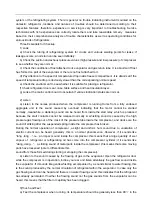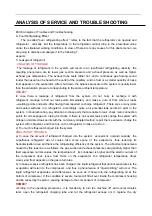
system or the refrigerating system .There is general no trouble indicating instrument mounted on the
domestic refrigerator ,locations and natures of troubles should be determined according to their
respective features ,therefore ,experience in servicing is very important to troubleshooting .Service
technicians with rich experience can correctly locate them and take reasonable remedy measures
based on their comprehensive analysis of trouble characteristics as well as operating conditions for
various kinds of refrigerators .
Three Essentials for Checkup
1) Look
a) Check the tubing of refrigerating system for cracks and various welding points for leaks ;if
leakage occurs ,an oil stain can be seen definitely .
b) Check the suction and exhaust pressure values (high pressure and low pressure) of compressor
to see whether they are normal .
c) Check the conditions of frost attached to its evaporator and gas return tube .It is abnormal if frost
has formed on part of the evaporator or there is no frost attached to it .
d) Pay attention to the speed of temperature drop inside freezer compartment .It is abnormal if the
speed of temperature drop is obviously slower than the corresponding normal speed .
e) Check the environment to see whether it is suitable for placing a refrigerator .
f) Check refrigerator door seal ,case ,table surface and heat insulation layer .
g) Look at the main control board to ascertain if various indication states are normal.
2) Listen
a) Listen to the noises produced when the compressor is running Hums from a fully enclosed
aggregate unit is the sound caused by overload indicating that the motor cannot be started
normally ,meanwhile ,a clattering sound can be heard from inside the start relay ,which is produced
because the start contacts cannot be released normally .A whistling sound is caused by the high
pressure gas flowing out of the crack of the pressure tube inside the compressor ,and clucks are the
sound of striking after the suspended spring inside the compressor has broken .
During the normal operation of compressor ,a slight and uniform hum sound due to undulation of
electric current can be heard generally ,this is a normal phenomenon .However ,if it sounds like
“tong ,tong …”,i.e., an impact sound inside the compressor ,this means that a large quantity of wet
vapour of refrigerant or refrigerating oil has come into the compressor cylinder ;if it sounds like
“dang ,dang…”, a striking sound of metal parts inside the compressor ,this means that some moving
parts have loosened (note to differentiate this
sound from those formed during starting or stopping the compressor).
b) Listen to the sound caused by the flowing of gas in the evaporator Open the refrigerator door
while the compressor is in operation ,incline your ear and listen attentively the gas flow sound inside
the evaporator .If it sounds like gentle whistling accompanied by a sound similar to water flowing ,this
is the sound produced by the normal circulation of refrigerant within the evaporator .In case only the
gas flowing sound can be heard and there is no water flowing sound ,this indicates that the refrigerant
has already percolated .If neither the flowing sound nor the gas sounds from the evaporator can be
heard ,this means that the filter or capillary has been clogged .
3)Touch and Feel
a) Feel the compressor when running ,its temperature should be generally less than 90
℃
in the












































